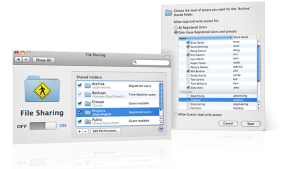Software > Operating Systems
Networks > Getting A Network
Mac OS X Server in mixed environments
By Michelle Murrain
This is an overview of the functionality of Mac OS X server, how it can work with both Mac and Windows desktops, and how it compares to other server operating systems. Detailed here are specific server functions, such as mail, web, and others.
Macintosh Operating System (OS) X server, which is a modified version of Mac OS X, is very full-featured server operating system that can provide a variety of server functionality. It works very well in an environment of desktops that are both Macintosh and Windows (and, in fact, will work fine with Linux desktops as well).
Because Mac OS X server (the most current version is called “Leopard Server”) has a UNIX base (it is based on the BSD kernel) all of the applications and utilities that will work on UNIX are available for use on Mac OS X server. Some functions, like file sharing, have easy interfaces for setting up and configuration. Other kinds of functions might involve some command line manipulation to get to work.
In addition, it seems that Apple has chosen to build all of its tools on open standards (which we’ll be detailing here). This makes it that much easier for cross-platform functionality. The challenge, however, is that for the most part, Microsoft Windows Operating System and Microsoft applications are further behind in adopting these open standards than Apple or open source developers.
Mac OS X Server as a file server and print server

View larger image of Mac file sharing
The Mac OS includes a number of file sharing protocols. AFP (Apple Filing Protocol) is the standard used between Macintosh computers. Mac OS X server also supports file and printer sharing using the SMB (Server Message Block) protocol (the protocol Microsoft Windows uses for file and print sharing), as well as NFS (Network File System) and others. This means that sharing files on a Mac OS X server with a wide variety of desktops is relatively straightforward, no matter what the OS of those desktops are.
It is very easy to determine which users have permissions to specific files or folders. This allows for a high level of configuration and is often referred to as a granular permission system. In addition, as long as you have the printer drivers for the desktop operating systems, sharing printers is straightforward in a mixed environment as well.
Once the shares and printers are set up, they will be discoverable on the desktops by navigating the network.
Mac OS X server as an intranet server
Mac OS X server comes with Apache, the powerful and well-established web server software. Because anything set up using Apache can be seen through a web browser, this means that desktops with web browsers can access the intranet.This web server can also be used for public web hosting.
Leopard Server also includes a new wiki application, which can be used with any web browser. Of course, it is also possible to install any web application software that works with Apache, such as a content management system like Drupal or Joomla, or wiki software like MediaWiki, or a project management system, for example.
The webserver and native wiki server are easy to set up via a graphical user interface. However, installing some other kinds of web application frameworks and software will involve using the command line. Many newer web applications, such as Content Management Systems, Wikis and others, do have very easy web-based installers.
Mac OS X server as a mail and calendar server
Although Microsoft Exchange cannot run on the Mac OS, its mail server is based on open standards, and can provide POP, IMAP and SMTP services to any desktop email client. In addition, their calendar server (called “iCal server”) integrates best with iCal (Apple’s desktop calendar client) but uses the new open standard called CalDAV, which a few cross-platform calendar clients, notably Mozilla Sunbird, are using. CalDAV allows for full-featured shared calendaring, such as shared scheduling.
However, CalDAV is a very new standard, and as of yet, no Microsoft applications support it. Some Microsoft applications do support the iCalendar standard, so you can subscribe to calendars on the iCal server, but that won’t allow for shared scheduling.
Apple’s Bonjour
Bonjour is Apple’s technology for sharing resources over the network with little or no configuration of those resources. It allows computers within a network to see and recognize printers, file shares and other resources. Bonjour is available for both Windows and Linux, so it is possible to have Windows and Linux desktops see and browse resources on the Mac OS server. In addition, Macs can browse resources available on Windows and Linux computers if Bonjour has been installed.
Other services
Mac OS X server includes, or can be implemented with, a variety of other server functions that can be used in environments with both Macs and PCs. For example, OS X server comes with what they call the “iChat” server, but is really underneath a Jabberserver, which is an open standard, and there are Jabber chat clients for all platforms (GTalk uses Jabber.) In addition, you can set up a VPN using the open standard L2TP/IPSec to provide encrypted tunneling to your network. This can be used with any platform.
Implementing OS X server
Unfortunately, because Apple’s OS X only runs on Macintosh computers, you have to either by an XServe, which Apple’s server hardware, which is in a rack-mountable form factor, or install Mac OS X server on a Macintosh that you presently have. It is quite a bit more expensive than the standard Mac OS X software, and comes in a 10-user (£319) and unlimited user (£629) versions.
Mac OS X server vs. other operating systems for mixed environments
If your network is primarily Windows-based, and a majority of your desktops are running Windows, there isn’t much cost-effectiveness to gain by adding Mac OS X server to the mix. Implementing Windows Server 2008 (the most recent version of Window server) might be a good option. However, one very important thing to remember is that some things that come native to the Mac OS X server (such as email) must generally be paid for in addition to the cost of Windows Server.
Because Linux-based servers are also able to run all of the standards-based server applications and utilities, the primary difference between running Mac OS X server and running a Linux server is ease of use. All of the applications (file and print server, email server, web server, wiki, chat server, etc.) can be installed and run on a Linux server (and generally cost nothing to acquire.) But the availability of Linux-knowledgeable help is an important factor here. But this might be a quite cost effective alternative for networks that are more PC than Mac.
Summary
If you have an office network that includes a significant number of Macintosh computers, as well as PCs, and you have Mac-knowledgeable people who can administer the server, then a computer running OS X server is probably the best way, and most cost-effective way to get the broadest amount of functionality available for most platforms. If you have few Macs, it is likely better to go with a Windows or Linux based file server, since it is probably not as cost-effective as Mac OS server in that situation.
About the author
Michelle Murrain
MetaCentric Technology Advising and Nonprofit Open Source Initiative
Glossary
AFP, Apache, Browser, BSD, Command Line, Email Client, Email Server, Hardware, Hosting, IMAP, Line, Linux, MAC, Network, NFS, Operating System, Protocol, SMB, SMTP, Software, UNIX, VPN, Web Browser, Web Server, Wiki
Related articles
- Open Source alternatives to Microsoft Exchange
- Open Source alternatives to Windows on servers
- So You Think You Want a Server?
Published: 11th April 2008
Copyright © 2008 Michelle Murrain
 This work is licensed under a Creative Commons Attribution-NonCommercial-NoDerivs 2.0 UK: England & Wales License.
This work is licensed under a Creative Commons Attribution-NonCommercial-NoDerivs 2.0 UK: England & Wales License.
